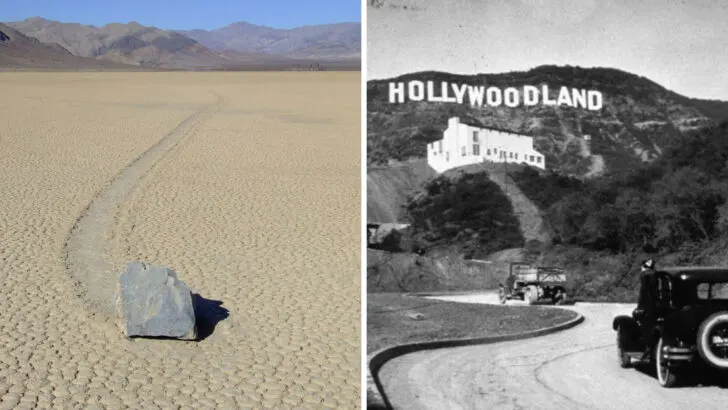California, often synonymous with sunny beaches and Hollywood glitz, holds a treasure trove of peculiar and fascinating stories.
From ghost towns to mysterious natural phenomena, the Golden State is layered with unexpected wonders.
Here are 20 captivating facts that reveal the lesser-known, yet intriguing dimensions of California.
California Has a “Ghost Town” That’s Still Technically a State Park
Frozen in time, Bodie is a ghost town located in the Bodie Hills east of the Sierra Nevada. Once a bustling gold rush center, it is now preserved in a state of “arrested decay.” Visitors can wander the streets where saloons and homes stand empty, evoking echoes of a lively past.
Designated a California State Historic Park, Bodie provides a rare glimpse into the boom-and-bust cycles of mining towns in the Old West.
The rusting remnants of its heyday remain, from the church spire to the dilapidated schoolhouse, inviting exploration and reflection on history’s fleeting nature.
It’s Home to the Tallest Tree on Earth
Hidden deep within Northern California’s Redwood National Park is “Hyperion,” the tallest known living tree on Earth. Standing at a dizzying 379 feet, this coast redwood is a testament to nature’s grandeur.
Discovered in 2006 by naturalists, its exact location remains undisclosed to protect it from environmental impact. Redwoods, known for their impressive height and long lifespans, symbolize the majestic wilderness of California.
The mystery shrouding Hyperion adds to its allure, drawing enthusiasts eager to experience the awe-inspiring scale and serene beauty of these ancient giants.
There’s a Town Named “Zzyzx” — and It’s Real
Zzyzx, a small and curious place in the Mojave Desert, was once envisioned as a health resort by a quack doctor in the 1940s. Named to be the “last word in health resorts,” today it hosts a desert studies center operated by California State University.
The settlement’s bizarre name and remote location capture the imagination of travelers passing through. Zzyzx serves as a reminder of the eccentric dreams that dot California’s landscape.
It stands as a testament to the quirky and bold ventures that occasionally find their way into history books.
A Section of California Once Tried to Secede as the “State of Jefferson”
In 1941, a band of counties in Northern California and Southern Oregon proposed the creation of the “State of Jefferson.” Frustrated by inadequate infrastructure and neglected roads, local citizens aspired to form a new state. Though the secession didn’t materialize, the spirit of independence lingered.
The movement gained traction when a sheriff famously blocked a highway, handing out proclamations of independence. Today, Jefferson is celebrated in the region, with flags and signs bearing its emblem.
This unique episode underscores the persistent drive for self-determination and community identity.
It’s the Birthplace of the Internet
The seeds of the digital age were sown in California when the first message was sent over ARPANET from UCLA in 1969. This groundbreaking achievement marked the beginning of the internet, forever altering global communication and connectivity.
In a modest computer lab, researchers transmitted the message “LO,” intending to send “LOGIN” before a system crash. This small step paved the way for a technological revolution.
The legacy of this moment lives on, as California continues to be a hub for innovation and technological advancement.
There’s a Forest of Albino Redwoods
In select coastal forests of California, rare albino redwoods, or “ghost trees,” stand out with their lack of chlorophyll. They are among nature’s oddities, surviving by parasitically drawing nutrients from their healthier neighbors.
These trees, with their ethereal white needles, inspire curiosity and wonder. Scientists study them to understand genetic mutations and ecosystem interactions.
The presence of albino redwoods highlights the complexity and diversity of California’s natural landscapes, offering a unique opportunity to explore the unknown workings of nature.
Home to the Largest Outdoor Pipe Organ
San Diego’s Spreckels Organ Pavilion boasts one of the largest outdoor pipe organs in the world. Situated in Balboa Park, this magnificent instrument has been enchanting audiences since 1915 with its powerful sound and intricate design.
The organ’s grand structure includes over 5,000 pipes, played regularly during public concerts. It serves as a cultural landmark, drawing music lovers and tourists alike.
The pavilion stands as a vibrant testament to the artistic and musical heritage that thrives in California, offering a communal space for celebration and creativity.
You Can Ski and Surf in the Same Day
California’s unique geography allows for the extraordinary possibility of skiing in the morning and surfing by afternoon. From the snowy Sierras to the sunny beaches, adventurous souls can experience both winter and summer sports in a single day.
This rare opportunity is a testament to California’s diverse landscapes. The Golden State’s varied climate zones offer endless recreational possibilities, making it a paradise for outdoor enthusiasts.
Whether carving through powder or catching waves, the thrill of this dual experience is unmatched.
The World’s Oldest Living Organism Lives Here
In the White Mountains of California, the ancient bristlecone pine known as “Methuselah” stands as the world’s oldest living organism. At over 4,800 years old, it predates the pyramids and continues to thrive in a harsh environment.
Its twisted and gnarled branches tell tales of resilience and endurance. Revered by botanists and nature lovers, Methuselah embodies the timeless beauty of life.
Its presence is a reminder of nature’s ability to adapt and persist through millennia, offering a profound connection to the past and a symbol of survival.
You Can Drive Through a Living Tree in California
Deep in Northern California’s redwood forests stands the Chandelier Tree — a massive, 276-foot tall redwood with a tunnel carved through its trunk.
What makes it truly incredible? It’s still alive. Visitors can actually drive their cars through the tree, making for one of the most uniquely Californian road trip stops you’ll ever find.
It Has a Town Where Chickens Rule the Roost
In Fair Oaks, California, chickens roam freely, strutting through streets and charming locals and visitors alike. Embraced as unofficial mascots, these feathered residents have become an integral part of the community.
The town celebrates its unique avian population with chicken-themed events and festivals. This quirky embrace of nature within an urban setting showcases a love for individuality and community spirit.
Fair Oaks stands as a testament to harmonious coexistence between people and wildlife, adding a touch of whimsy to everyday life.
It’s Home to a Sea of Moving Rocks
Death Valley’s Racetrack Playa is a natural wonder where rocks mysteriously move across the desert floor, leaving long trails behind them. This curious phenomenon puzzled scientists for decades.
Recent studies revealed that thin ice sheets and light winds propel the stones, creating the illusion of movement. The moving rocks of Racetrack Playa continue to captivate imaginations, drawing visitors to witness the spectacle.
This remarkable occurrence underscores the dynamic and ever-changing nature of California’s landscapes.
The Winchester Mystery House Is a Mansion Built by Ghosts—Sort Of
The Winchester Mystery House in San Jose is a sprawling, enigmatic mansion with staircases leading nowhere and doors opening into walls. Built by Sarah Winchester, the widow of a gun magnate, the house was designed to confound vengeful spirits.
Filled with oddities and architectural quirks, it reflects an eccentric vision shaped by grief and superstition. Visitors marvel at its maze-like layout, intrigued by the legends surrounding its creation.
The house stands as a testament to the human response to loss and mystery, offering a fascinating glimpse into a haunted past.
You Can Visit a “Museum” Made of Garbage
The Museum of Jurassic Technology in Los Angeles defies easy categorization. It offers visitors a surreal blend of science, art, and oddity, challenging perceptions and sparking curiosity.
Exhibits range from the bizarre to the brilliant, inviting reflection on the nature of knowledge and belief. This eccentric institution celebrates the obscure and the overlooked, making it a unique cultural gem.
The museum’s enigmatic charm captivates those who seek unconventional experiences, offering a journey into the bizarre and the unexpected.
The Salton Sea Is an Accidental Lake
Created by a 1905 engineering mishap, the Salton Sea was an unintended consequence of flooding from the Colorado River. Once a vibrant resort area, it is now plagued by environmental challenges and a declining water level.
The lake’s eerie, post-apocalyptic landscape draws photographers and adventurers. Its history is marked by boom and decline, mirroring the broader story of human impact on nature.
The Salton Sea stands as a stark reminder of ecological fragility and the unintended consequences of human endeavors.
There’s a City That’s a Literal Law-Free Zone
Known as “the last free place in America,” Slab City is a squatter community in the California desert with no electricity or governing laws. It attracts those seeking an unconventional lifestyle, artists, and free spirits alike.
The city’s colorful murals and unique structures reflect its residents’ creativity and independence. Life here challenges conventional norms, offering a glimpse into alternative living.
Slab City embodies the spirit of autonomy and freedom, all set against the stark beauty of the desert landscape.
A Giant Thermometer Tells You Just How Hot It Is
In Baker, California, the world’s tallest thermometer stands as a tribute to the highest temperature recorded nearby in Death Valley. Towering at 134 feet, it symbolizes the extreme heat of the region.
Constructed in 1991, this towering landmark captures the attention of travelers and serves as a quirky reminder of the desert’s harsh climate.
The thermometer stands as a testament to human ingenuity and the ability to commemorate nature’s extremes in a playful yet meaningful way.
The Hollywood Sign Once Said “Hollywoodland”
Originally erected in 1923 as a real estate advertisement, the Hollywood Sign initially read “Hollywoodland.” Over time, the sign transformed into a global icon synonymous with the entertainment industry.
The sign’s evolution mirrors the growth and change of Hollywood itself. Its status as a cultural landmark is cemented in the public imagination, representing the dreams and ambitions of countless artists and entertainers.
The history of the Hollywood Sign is a chapter in the story of Los Angeles, capturing the essence of fame and fortune.
There’s a Bubblegum Alley That’s Exactly What It Sounds Like
Bubblegum Alley in San Luis Obispo is a sticky spectacle where visitors have left their mark with chewed gum for over half a century. This narrow alley has become an evolving canvas of colors and textures.
While some find it appealing and artistic, others see it as an unsightly mess. Regardless, Bubblegum Alley remains a popular and peculiar attraction, capturing the whimsical and rebellious spirit of the community.
It stands as a testament to spontaneous creativity and unconventional art forms.
You Can Find a Replica of Stonehenge Made of… Junked Cars
In Santa Maria, a quirky homage to the ancient Stonehenge exists, made entirely from junked cars. “Carhenge” features upended vehicles painted and arranged to mimic the iconic monument.
This playful interpretation mixes art, humor, and commentary on consumer culture. Visitors marvel at the creativity and irony embodied in this peculiar installation.
Carhenge stands as a testament to human ingenuity, offering a light-hearted yet thought-provoking reflection on the intersection of art and recycling.

